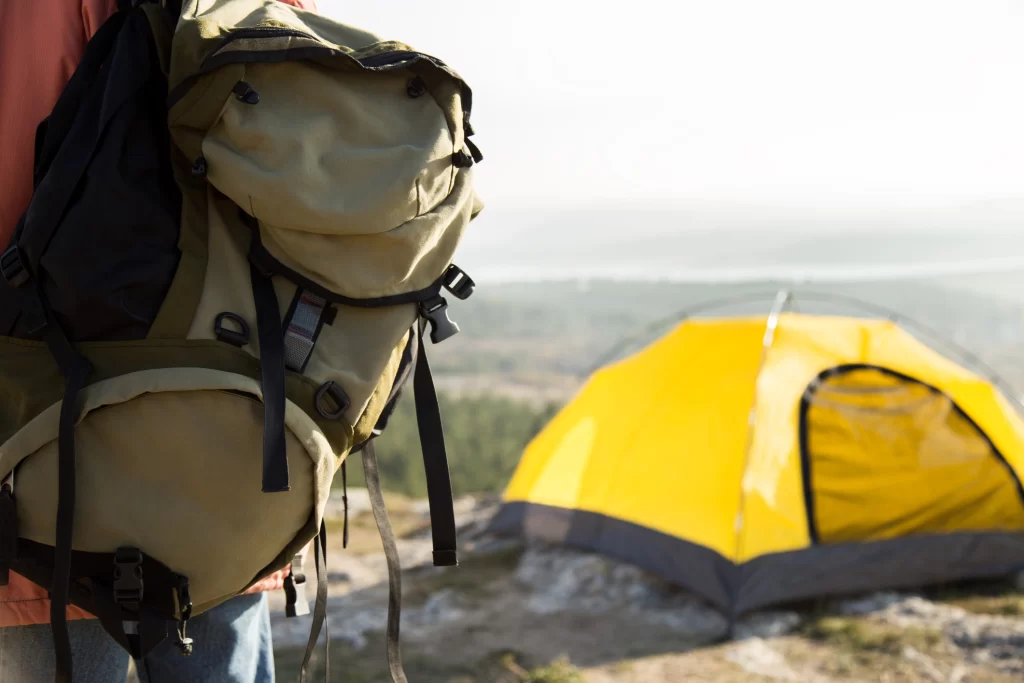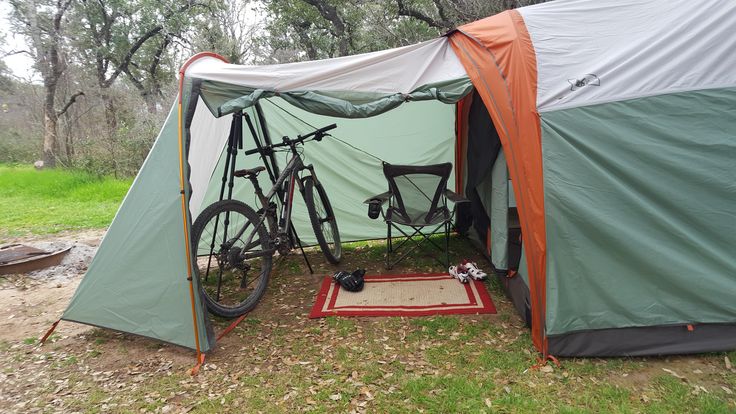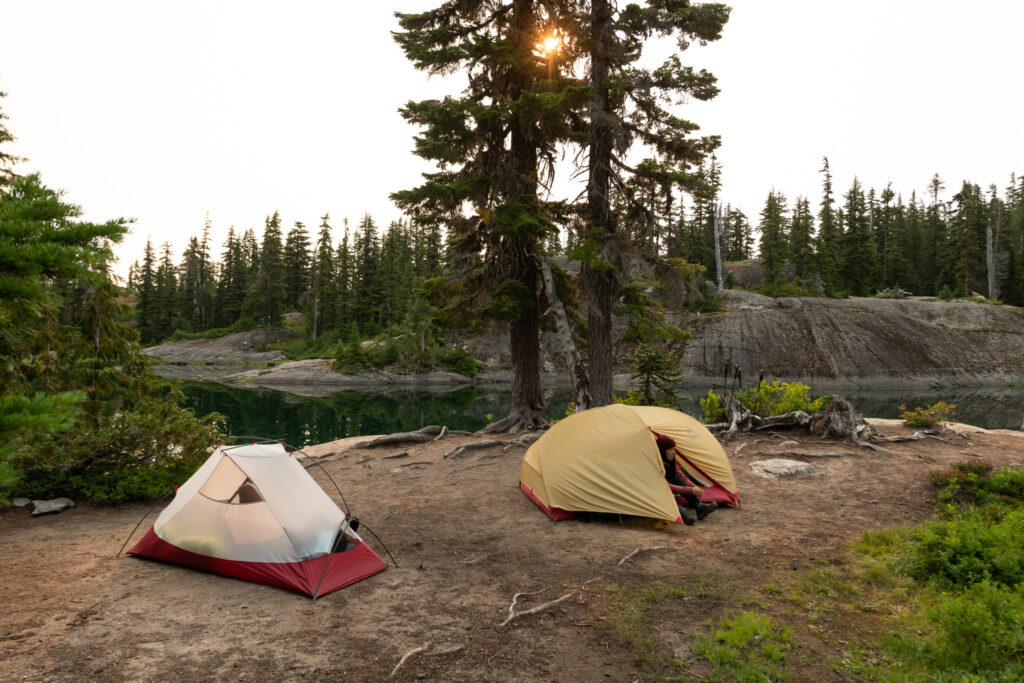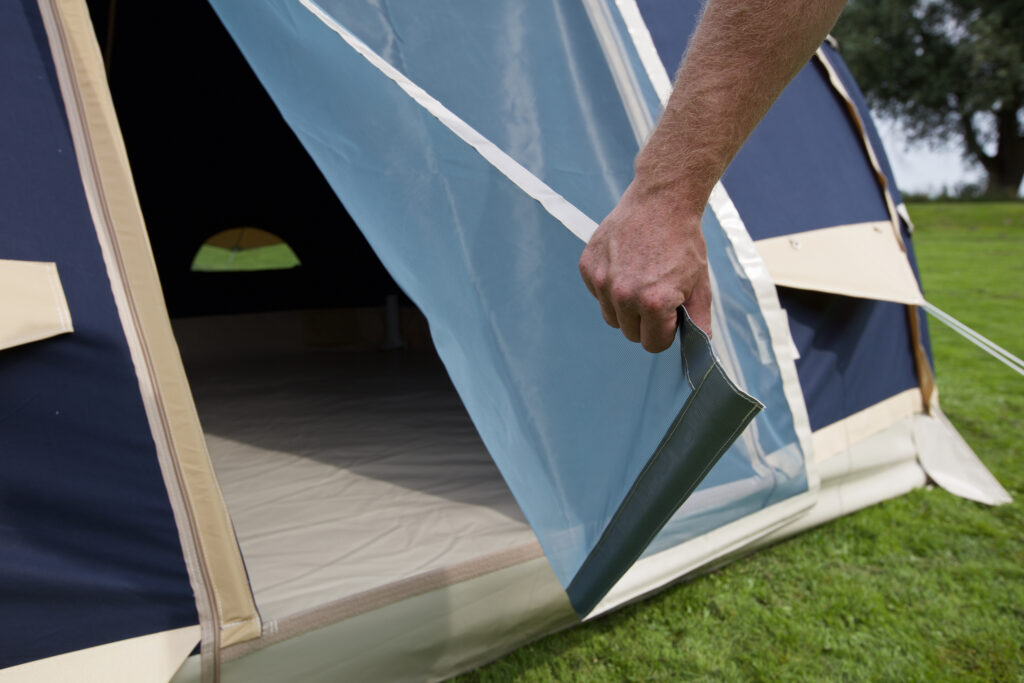You can do a lot with your backpack tent without carrying too much weight. The combination of water, food, and supplies makes the hike more difficult than it needs to be. One of the most important things to consider is the weight of your backpack tent.

In this article, you will find the answer to your questions concerning the average tent weight. Besides, I will describe what parts of the tent you should consider while choosing a tent for your outdoor adventures.
First, let’s get answers to frequently asked questions concerning the tent weight.
What is an average weight of a tent?
The average weight of a tourist backpacking tent is from 1-2 to 6 pounds. Tourist backpacking tents are divided into ultra-light, light, and traditional. Choosing the right type of backpacking tent for your backpack will make your camping experience easier without sacrificing the quality of the camping tent.
How much does a 2-person tent weigh?
A good trail weight for a two-man backpacking tent is 2.2-2.6 pounds, and an excellent weight for a two-man backpacking tent is 1.8 pounds and below. Backpacking tents of this type have an average or high degree of wind resistance, which is why they are quite low.
How much does a 4-person tent weigh?
The usual trail weight of a 4-person travel chamber is about 7.1 pounds for the backpacking tent. This means that if there are four people in your group, it will be comfortable to accommodate a ward that weighs 7.1 pounds or less.
How heavy is a 6-person tent?
The typical weight of a 6-person family/car trail weight of a tent body is about 25.5 pounds. So, when you are shopping for a 6-person family backpacking tent weight, it would be ideal to choose a backpacking tent that weighs around 25 pounds for an overall good car camping experience.

What is the heaviest part of a tent?
The weight of a tent weight depends on various factors such as its size and the type of material it is made from, but with most ultralight tents, a significant portion of the weight is concentrated on the floor. Because that’s what keeps the passengers and any extra gear they bring.
In most cases, the weight will be somewhere between two and three pounds per square foot.
So, therefore, we can say that the heaviest part of the backpacking tents is their floor.

Now let’s talk about the parts of a tent to take into consideration.
The weight
The first thing you should pay attention to when considering any tourist backpacking tent weighs is its weight.
All other characteristics and conveniences are immediately perceived a little differently when it turns out that for the sake of them you will have to carry extra weight.
In the description of the backpacking tent weighs, two numbers are usually given: its minimum weight and full (max) weight.
The minimum weight is only the backpacking tent itself, without pegs, repair kits, packing cases, and other things.
What is light and what is a heavy backpacking tent? Due to the advent of more advanced materials, modern backpacking tents are gradually becoming lighter and lighter. On Internet forums, one can often find opinions that a light backpacking tent weighs less than 1 or 1.5 pounds per person.
In fact, everything is a little more complicated. The weight of the backpacking tent weigh does not grow linearly with the increase in its capacity.
So, a five-seater backpacking tent, other things being equal, in terms of one inhabitant will always weigh less than a double one.
Why might a tent be heavier? As a rule, this is due to the large size of its vestibules, which require additional fabric and arches to support them.
But, most often, this is still a consequence of the use of cheap and, accordingly, rather heavy materials.

Inputs
If people lie alone in a tent, then there may well be only one entrance. So everyone enters/exits or collects their things especially without disturbing the rest.
But if the sleeping places are located across, then it is desirable to have two entrances. This noticeably speeds up the process of morning preparations and sleepy crawling out of the tent. The last one lying against the wall will not have to wait every time until all his neighbors get dressed, put on their shoes, and crawl out.
With the number of inputs, there is another subtle point.
If you are traveling in the southern regions, where warm, stuffy nights are typical, or if you just sometimes allow yourself to lie in a tent after dinner, then two entrances come in handy.
When open, they allow the tent to blow through and get the heated air out of it much better, making it much more pleasant to be inside. The entrances of the inner tent are often provided with “double doors”.
And the second – is from a mosquito net, which can be left in case of heat, so as not to be eaten by mosquitoes at the same time.

Tambour
Why do you need a vestibule in a tourist tent:
- Take off and leave your shoes there (and, in case of rain, other wet clothes). In order not to climb into the inner tent with them, where a priori cleanliness and dryness reign.
- Store the bulk of your things in it: backpacks, groceries, bowlers, saws/axes, and so on, which is unsuitable to lie outside at night due to rain or potential theft.
- In case of bad weather, prepare breakfast on a gas burner without getting out of your sleeping bag. When it’s cold or it’s raining, this is a very nice option. Just be sure to slightly open the entrance and ventilation, so as not to inadvertently burn out.
The size of the vestibules can be very different: from 30 inches, in which you can leave only a pair of shoes, to a spacious one and a half to two meters. To the vestibule, as well as to the residential part of the tent, the term “habitability” is applicable.
If its ceiling is strongly sloping, then, despite its vast size, it is very inconvenient to be in it or pull off a wet jacket.
Therefore, to increase the habitability of vestibules, additional arcs are often included in the design of tents.
There is always a great temptation to take a tent with bigger vestibules. Comfort, as you know, does not happen much. But it is still desirable to objectively evaluate what they will be used for. For example, for storing bicycles or a large amount of equipment in a region that is troubled in terms of “borrowing” other people’s things.
Then you understand that an additional 0.5–1 pounds behind you is a necessary tribute to the circumstances. In most cases, one or two vestibules of medium size, 70-100 inches, will suffice.
And sometimes you can do something more cunning – take a light three-person tent for two with almost no vestibules and comfortably place your belongings in an empty place. At the same time, if anything, there will always be a reserve for putting one more comrade with you.

Materials
The materials from which tents are made is a really big topic that can be discussed for a long time. Therefore, here we will focus on several important points. This is important when choosing a material for the average user.
The roof frame is made of fiberglass (glass) – cheaper, or aluminum – more expensive, but simpler and more reliable. Medium to high roofs almost always feature tall aluminum studs. These tents are usually made from fiberglass. In principle, there is nothing wrong with a fiberglass arch for a calm, laid-back stay.
You just need to understand that such a tent will be heavier than its counterpart with an aluminum arc and is intended only for light working situations. The main places not to take fiberglass are the mountains, where the strong UV rays cause things to quickly erode and break, causing a lot of problems.
The tarpaulin used for tourist tents has become immovable. Modern tent awnings and underlays are made from polyurethane (PU) synthetic fabric (polyester or nylon). The more layers of impregnation, the stronger and more waterproof the fabric will be. In this case, the product name refers to the PU and water resistance values in feet.
Many spears broke due to the importance of waterproofing. This was once considered one of the main ways tourists chose a tent. Because the higher it is, the colder it will be for you and your clothes. At 10,000 feet, it will be protected from the rain.
But in theory, it is. Usually, each manufacturer measures this value independently. Someone shows a drawing of new fabric from the factory, someone has an objective value – the results of testing the material after a year of operation.
In addition, you need to know how all these things are made, whether the patterns are successfully made, and whether it is done at a high level. They are very important. Therefore, it is very difficult to compare products of different brands in this parameter.
And the roof now, more or less for the manufacturer, is now completely different. Like a modern umbrella – open marriage and divorce. Currently, it is found only in low-quality products. Often users confuse the tightness of the material with a leaking roof, but physically it is quite different.
The only thing you can really find in a suspicious roof is the presence of taped seams. If not, then it’s better to stop. During prolonged rains, these lines are less wet. And the larger the tent, the more elastic and flexible the fabric.
In recent years, silicone additives (Silicone or Si) are increasingly being used in lightweight fabrics instead of traditional polyurethane (PU) – this is a very simple material. For example, preparing the same tent for two people with a “silicone” awning will weigh 2.3 pounds instead of 3 pounds.
In addition, the silicone-impregnated fabric is strong, and because the threads are not connected together, it can move freely and distribute the load. However, at the same time, it is not often used because it is very expensive and requires complex tailoring technology.
In a small tent, the bottom is usually made of reinforced polyethylene (“tarp”, like the fabric in a salesman’s bag) instead of fabric. A light walk or outdoor recreation is a life-changing opportunity.
Keep in mind, however, that such items are heavier than clothing, so the tent becomes larger when folded. Folding the tent frequently, especially in hot weather, loosens the stacks and allows water to seep through.

Seasonality of tents
In many cases, manufacturers indicate the environmental conditions under which one or more of their products will be manufactured. At the same time, in the description, you will find words like “summer”, “three seasons” (spring-summer-autumn), and “four seasons” (sunny, warm).
This information can be very helpful, but it needs to be properly explained and interpreted. The main difference between a seasonal tent is how it is protected inside from the outside wind. Summer models have an open curtain inside the tent to provide fresh air in cold weather.
Three-season and winter models use thin fabrics instead of curtains to reduce airflow and exterior drafts. In addition, many four-season models have wind skirts that can be covered by rocks.
However, remember that in terms of proper thermal insulation, a winter tent (four seasons) is not much warmer than a three-season tent. And it’s light because there are two layers of fabric that separate the snow from the road. To provide all the comfort you need on cold days, a well-weighted sleeping bag.
Advantages and disadvantages of choosing a light or heavy tent
Whether you choose a light or heavy tent, both types of tents have their advantages and disadvantages.
However, the following pros and cons are true for specific use cases.
Advantages of a light tent
- Easy to carry over long distances.
- Easy to set up.
Benefits of a heavier tent
- Usually offers more space.
- Can withstand extreme weather conditions.
Cons of a light tent
- Not ideal for extreme weather.
- Less interior space and features.
Cons of a heavier tent
- Not very suitable for single use.
- Setup and takeoff require additional time.

Single and double wall tent
To further complicate matters, tents also come in single-wall or double-wall designs. Freestanding double wall tent has a tent and a screen, while single wall tents construction combines materials such as mesh windows, zippered railings, and a tent fly.
Single wall tents reduce overall trail weight without sacrificing comfort.
Like traditional tents, they use guy wires, stakes, and trekking poles (or light tent poles) to raise the person tent. Single wall and trekking poles tents are good options for early spring or late fall, but not for bad weather and insects.

Other tent considerations
While size, seasonality, and type of pitch are the main factors you should consider when choosing the weight of a camping tent, consideration of other characteristics can determine a tent’s suitability for trail living.
Remember, this will be a shelter away from home. Here are some other things to consider when buying a camping tent if weight is a concern.
- Doors. Having two doors will make the tent heavier than a single door. If you are sharing a tent with someone, it would be nice to have two doors so you don’t have to crawl over the other person. If it’s just you, consider a one-door tent.
- Internal storage. A place to put your hat, mobile phone, or water bottle is always nice to have in a tent. While this may add extra weight, it’s a nice perk for your tent. You can also buy the loft separately.
- Traces. Footprints can extend the life of a tent because they provide a waterproof and durable layer between the tent and the ground. Some backpackers choose to leave a trail at home to save weight, but if you’re hiking in wet or rocky terrain, it might be worth the extra ounces.

Conclusion
Tourist ultralight tents weigh from 1 to 6 pounds or more. It depends on which backpacking tent you choose: light, ultra-light, or traditional. You also need to keep additional components in mind, such as person tent poles and supports, when adding up the total packed weight of a person tent.
Indeed, packed weight is not the only factor to consider when choosing a lightweight tent. You’ll also want to think about price, indoor space, seasonality, building material type, and all the other features you need. But if you’re trying to decide between two identical backpacking tents, then packed weight measurement can be a useful factor to consider.
Well, in this article, I have tried to give you an average idea of how much a one-person tent weighs with some examples. Moreover, I believe that after reading this article, you will be able to decide how much packed weight your next lightweight tent should have.
Your Turn
What tent do you usually go camping with? Please share your experience of choosing your tent with other campers in the comments below.

My name is Olivia Kellison. I have been camping with friends and on my own for a long time. For me, camping is a great way to escape everyday life’s chaos. I started this blog because I have always had a passion for the great outdoors, and here I am gladly sharing what I know with other outdoor enthusiasts. It does not matter whether you are an experienced adventurer, or just planning your first trip, my blog will be of great help to you.

